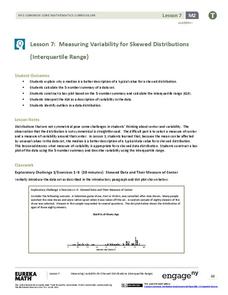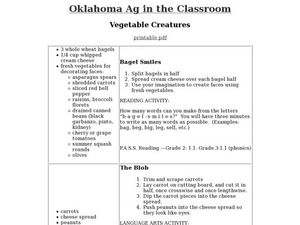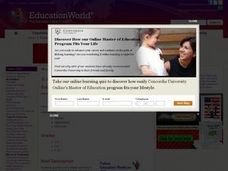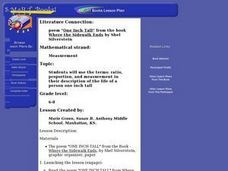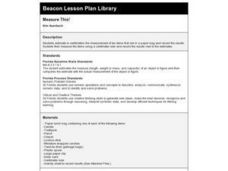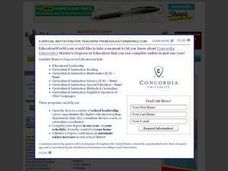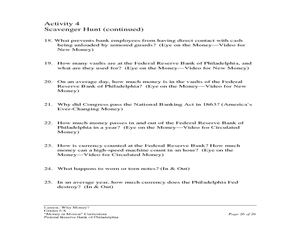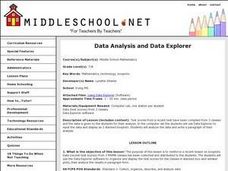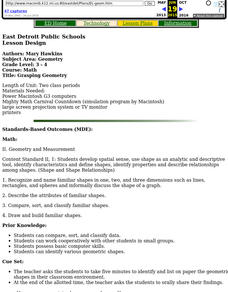Curated OER
No Foot, No Horse
Why do horses wear shoes? Why do people wear shoes? Using worksheets, which are embedded in the plan, learners write descriptive paragraphs about their own shoes, classify a pile of shoes, and also engage in math games about the variety...
EngageNY
Measuring Variability for Skewed Distributions (Interquartile Range)
Should the standard deviation be used for all distributions? Pupils know that the median is a better description of the center for skewed distributions; therefore, they will need a variability measure about the median for those...
Curated OER
Robots All Around Us
Student work in design teams to research robots, create a drawing of a robot they want to make, build a prototype of their robot, present their prototype and research, and write a descriptive paragraph about their creation.
Creative Educator
Dream Room Design
Junior designers brainstorm the elements that a bedroom might have, such as a bed, television, and dresser. They identify which items are needs and which are desires. They practice measurement skills in the classroom by determining its...
Curated OER
Vegetable Creatures
Students use different foods to enhance academic skills in all area contents. In this food activity lesson, students use food, such as "bugs on a log" (raisins on peanut butter celery) to estimate and practice multiplication. ...
EngageNY
Chance Experiments
Class members are introduced to probability using terms such as impossible, unlikely, likely, and certain. Numbers between zero and one are associated with the descriptions of probability. Pupils find the likelihood of chance experiments...
Curated OER
Sports and Hobby Math
Explore math concepts as they relate to real world situations. Young analysts consider a personal hobby or favorite sport and list three ways math is involved in the hobby. They create several related math story problems and write a...
Curated OER
"Mind Reader" Math Trick
Students perform a math-based card trick and explain the concepts behind the trick. They video tape classmates performing the trick. Finally, they write a paragraph explaining the trick.
Curated OER
Let Your Fingers Do the Estimating
Investigate estimation with the White Pages. Youngsters use the phonebook to estimate the average number of phone listings that can be found there. They write a paragraph explaining the processes they used in this challenge.
Curated OER
Design Your Dream Room
Students determine length, width, perimeter, and surface area, and work with two-dimensional representations of three-dimension objects to design and write descriptions of their dream bedrooms.
Curated OER
Shell Graphing
Fifth graders explore the four quadrants of a coordinate grid. For this graphing lesson, 5th graders trace sea shells in each of the four quadrants of a coordinate grid and then label the ordered pairs on each shell. For the...
Curated OER
Gummy Bear Math
First graders predict, collect data, and create a graph based on gummy bear colors they are given. In this graphing lesson plan, 1st graders first predict how many colors of gummy bears there are. They then count the colors, graph them,...
EngageNY
More Practice with Box Plots
Don't just think outside of the box — read outside of it! The 15th lesson in a 22-part unit provides pupils more work with box plots. Learners read the box plots to estimate the five-number summary and interpret it within the context....
Kenan Fellows
Weight and Balance of an Airplane
A career in aeronautics might be calling your class members. Building from the previous two lessons in the series, learners continue analyzing the mathematics of aeronautics. Groups create a paper airplane using paperclips for balance....
Curated OER
Governor's Garden
Students review types of polygons and list several examples of each. They assume the role of a landscape artist interviewing for a job. They create sketches of their plans for six polygonal gardens and write an expository paragraph...
Curated OER
poem "One Inch Tall" from the book "Where the Sidewalk Ends" by Shel Silverstein
Young scholars use the terms: ratio, proportion, and measurement in their description of the life of a person one inch tall.
Curated OER
How Would You Spend a Million Dollars?
Pupils plan and organize a theme to spend one million dollars. They select a theme, research prices of items on the Internet, organize the information into a spreadsheet, write an introductory paragraph, and create a final project.
Curated OER
Measure This!
Young scholars estimate the measurement in centimeters for common classroom objects. They check their estimations, discuss the differences and write a paragraph summarizing the activity.
Curated OER
Squanto's Science Lesson
Students explore Squanto's contribution to the settlers. They plant seeds and follow instructions for water and fertilization. Students keep a record of the growth of the seeds. They write a paragraph that tells what they learned from...
Curated OER
Why Money?
Students participate in a trading simulation to learn about barter and the benefits of using money. In this barter lesson, students participate in a trading simulation and learn about coincidence of wants. Students then use money cards...
Curated OER
Data Analysis and Data Explorer
Students use the Data Explorer software to organize and display the test scores for the classes in stacked box-and-whisker plots, then analyze the results in paragraph form.
Curated OER
Flying Geese
Students examine the Flying Geese quilt pattern, and discuss and identify the pattern. They write a paragraph titled, My Quilt Report, summarizing the information discussed about the quilt patterns.
Curated OER
Grasping Geometry
Students investigate geometric shapes in their environment, make a geometric design, and write paragraphs describing the design.
Curated OER
Dinosaurs: "If I had a Dinosaur"
First graders analyze what it would be like to own a dinosaur. In this dinosaur writing lesson, 1st graders review knowledge and key terms about dinosaurs in order to complete a one paragraph creative writing assignment. Students compile...

